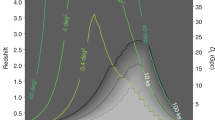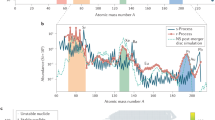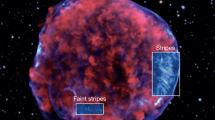Abstract
The physics of neutron stars is a remarkable combination of Einstein’s theory of general relativity and nuclear physics. Their interiors harbour extreme matter that cannot be probed in the laboratory. At such high densities and pressures, their cores may consist predominantly of exotic matter, such as free quarks or hyperons. Observations from the Laser Interferometer Gravitational-Wave Observatory (LIGO) and other gravitational-wave interferometers and X-ray observations from the Neutron Star Interior Composition Explorer (NICER) are beginning to provide information about neutron star cores and, therefore, about the mechanisms that make such objects possible. In this Review, we discuss what has been learned so far about the physics of neutron stars from gravitational-wave and X-ray observations. We focus on what has been observed with certainty and what should be observable in the near future, emphasizing the physical understanding that these new observations will bring.
Key points
-
The processes at play inside neutron stars are a combination of general relativity, quantum mechanics, particle physics and nuclear physics effects that cannot be replicated in the lab.
-
Gravitational-wave observations of binary neutron star mergers are beginning to provide information about the equation of state of supranuclear matter through constraints on the tidal deformability of neutron stars.
-
The X-rays emitted by hotspots on the surface of certain pulsars are starting to provide information about nuclear physics through constraints on the radius of neutron stars.
-
Future observations of gravitational waves and X-rays from LIGO, Virgo, Kamioka Gravitational Wave Detector (KAGRA) and the Neutron Star Interior Composition Explorer will provide unprecedented insights into the physics of neutron stars.
This is a preview of subscription content, access via your institution
Access options
Access Nature and 54 other Nature Portfolio journals
Get Nature+, our best-value online-access subscription
$29.99 / 30 days
cancel any time
Subscribe to this journal
Receive 12 digital issues and online access to articles
$99.00 per year
only $8.25 per issue
Buy this article
- Purchase on Springer Link
- Instant access to full article PDF
Prices may be subject to local taxes which are calculated during checkout





Similar content being viewed by others
References
Shapiro, S. L. & Teukolsky, S. A. Black Holes, White Dwarfs, and Neutron Stars: The Physics of Compact Objects (Wiley, 1983).
Kaspi, V. M. & Beloborodov, A. Magnetars. Annu. Rev. Astron. Astrophys. 55, 261–301 (2017).
Rawley, L. A., Taylor, J. H., Davis, M. M. & Allan, D. W. Millisecond pulsar PSR 1937+21: a highly stable clock. Science 238, 761–765 (1987).
Baym, G., Pethick, C. & Sutherland, P. The ground state of matter at high densities: equation of state and stellar models. Astrophys. J. 170, 299–317 (1971).
Ambartsumyan, V. A. & Saakyan, G. S. The degenerate superdense gas of elementary particles. Sov. Astron. 4, 187 (1960).
Chatterjee, D. & Vidaña, I. Do hyperons exist in the interior of neutron stars? Eur. Phys. J. A 52, 29 (2016).
Ivanenko, D. D. & Kurdgelaidze, D. F. Hypothesis concerning quark stars. Astrophysics 1, 251–252 (1965).
Lattimer, J. M. & Prakash, M. Neutron star structure and the equation of state. Astrophys. J. 550, 426 (2001).
Most, E. R. et al. Projecting the likely importance of weak-interaction-driven bulk viscosity in neutron star mergers. Mon. Not. R. Astron. Soc. 509, 1096–1108 (2022).
Troyer, M. & Wiese, U.-J. Computational complexity and fundamental limitations to fermionic quantum Monte Carlo simulations. Phys. Rev. Lett. 94, 170201 (2005).
Aoki, Y., Endrodi, G., Fodor, Z., Katz, S. D. & Szabo, K. K. The order of the quantum chromodynamics transition predicted by the standard model of particle physics. Nature 443, 675–678 (2006).
Baym, G. et al. From hadrons to quarks in neutron stars: a review. Rep. Prog. Phys. 81, 056902 (2018).
Nambu, Y. & Jona-Lasinio, G. Dynamical model of elementary particles based on an analogy with superconductivity. 1. Phys. Rev. 122, 345–358 (1961).
Alford, M. G., Rajagopal, K. & Wilczek, F. QCD at finite baryon density: nucleon droplets and color superconductivity. Phys. Lett. B 422, 247–256 (1998).
Dexheimer, V. A. & Schramm, S. A novel approach to model hybrid stars. Phys. Rev. C 81, 045201 (2010).
Tews, I., Krüger, T., Hebeler, K. & Schwenk, A. Neutron matter at next-to-next-to-next-to-leading order in chiral effective field theory. Phys. Rev. Lett. 110, 032504 (2013).
Read, J. S., Lackey, B. D., Owen, B. J. & Friedman, J. L. Constraints on a phenomenologically parameterized neutron-star equation of state. Phys. Rev. D 79, 124032 (2009).
Annala, E., Gorda, T., Kurkela, A. & Vuorinen, A. Gravitational-wave constraints on the neutron-star-matter Equation of State. Phys. Rev. Lett. 120, 172703 (2018).
Alford, M. G., Han, S. & Prakash, M. Generic conditions for stable hybrid stars. Phys. Rev. D 88, 083013 (2013).
Haque, N. et al. Three-loop HTLpt thermodynamics at finite temperature and chemical potential. J. High Energy Phys. 2014, 27 (2014).
Glendenning, N. K. & Kettner, C. Non-identical neutron star twins. Astron. Astrophys. 353, L9 (2000).
Page, D., Lattimer, J. M., Prakash, M. & Steiner, A. W. Minimal cooling of neutron stars: a new paradigm. Astrophys. J. Suppl. 155, 623–650 (2004).
Blaschke, D., Grigorian, H. & Voskresensky, D. N. Cooling of neutron stars: hadronic model. Astron. Astrophys. 424, 979–992 (2004).
Piekarewicz, J., Fattoyev, F. J. & Horowitz, C. J. Pulsar glitches: the crust may be enough. Phys. Rev. C 90, 015803 (2014).
Haskell, B. & Melatos, A. Models of pulsar glitches. Int. J. Mod. Phys. D 24, 1530008 (2015).
Fattoyev, F. J., Horowitz, C. J. & Lu, H. Crust breaking and the limiting rotational frequency of neutron stars. Preprint at https://arxiv.org/abs/1804.04952 (2018).
Haskell, B. & Schwenzer, K. Gravitational waves from isolated neutron stars. Preprint at https://arxiv.org/abs/2104.03137v1 (2021).
Saito, T. R. et al. New directions in hypernuclear physics. Nat. Rev. Phys. 3, 803–813 (2021).
Hulse, R. A. & Taylor, J. H. Discovery of a pulsar in a binary system. Astrophys. J. Lett. 195, L51–L53 (1975).
Cromartie, H. T. et al. Relativistic Shapiro delay measurements of an extremely massive millisecond pulsar. Nat. Astron. 4, 72–76 (2019).
Demorest, P. B., Pennucci, T., Ransom, S. M., Roberts, M. S. E. & Hessels, J. W. T. A two-solar-mass neutron star measured using Shapiro delay. Nature 467, 1081–1083 (2010).
Antoniadis, J. et al. A massive pulsar in a compact relativistic binary. Science 340, 448 (2013).
Abbott, B. P. et al. Observation of gravitational waves from a binary black hole merger. Phys. Rev. Lett. 116, 061102 (2016).
Abbott, R. et al. GWTC-2: compact binary coalescences observed by LIGO and Virgo during the first half of the third observing run. Phys. Rev. X 11, 021053 (2021).
Abbott, B. P. et al. GW170817: observation of gravitational waves from a binary neutron star inspiral. Phys. Rev. Lett. 119, 161101 (2017).
Flanagan, E. E. & Hinderer, T. Constraining neutron-star tidal Love numbers with gravitational-wave detectors. Phys. Rev. D 77, 021502 (2008).
Hinderer, T., Lackey, B. D., Lang, R. N. & Read, J. S. Tidal deformability of neutron stars with realistic equations of state and their gravitational wave signatures in binary inspiral. Phys. Rev. D 81, 123016 (2010).
Abbott, B. P. et al. GW170817: measurements of neutron star radii and equation of state. Phys. Rev. Lett. 121, 161101 (2018).
Chatziioannou, K. Neutron-star tidal deformability and equation-of-state constraints. Gen. Relativ. Gravit. 52, 109 (2020).
Lindblom, L. Spectral representations of neutron-star equations of state. Phys. Rev. D 82, 103011 (2010).
Greif, S. K., Raaijmakers, G., Hebeler, K., Schwenk, A. & Watts, A. L. Equation of state sensitivities when inferring neutron star and dense matter properties. Mon. Not. R. Astron. Soc. 485, 5363–5376 (2019).
Tews, I., Carlson, J., Gandolfi, S. & Reddy, S. Constraining the speed of sound inside neutron stars with chiral effective field theory interactions and observations. Astrophys. J. 860, 149 (2018).
Yagi, K. & Yunes, N. Approximate universal relations for neutron stars and quark stars. Phys. Rep. 681, 1–72 (2017).
Yagi, K. & Yunes, N. I-Love-Q: unexpected universal relations for neutron stars and quark stars. Science 341, 365–368 (2013).
Yagi, K. & Yunes, N. I-Love-Q relations in neutron stars and their applications to astrophysics, gravitational waves and fundamental physics. Phys. Rev. D 88, 023009 (2013).
Yagi, K. & Yunes, N. Binary Love relations. Class. Quantum Gravity 33, 13LT01 (2016).
Yagi, K. & Yunes, N. Approximate universal relations among tidal parameters for neutron star binaries. Class. Quantum Gravity 34, 015006 (2017).
De, S. et al. Tidal deformabilities and radii of neutron stars from the observation of GW170817. Phys. Rev. Lett. 121, 091102 (2018); erratum 121, 259902 (2018).
Maselli, A., Cardoso, V., Ferrari, V., Gualtieri, L. & Pani, P. Equation-of-state-independent relations in neutron stars. Phys. Rev. D 88, 023007 (2013).
Chatziioannou, K., Haster, C.-J. & Zimmerman, A. Measuring the neutron star tidal deformability with equation-of-state-independent relations and gravitational waves. Phys. Rev. D 97, 104036 (2018).
Carson, Z., Chatziioannou, K., Haster, C.-J., Yagi, K. & Yunes, N. Equation-of-state insensitive relations after GW170817. Phys. Rev. D 99, 083016 (2019).
Tan, H., Dexheimer, V., Noronha-Hostler, J. & Yunes, N. The slope, the hill, the drop, and the swoosh: learning about the nuclear matter equation of state from the binary Love relations. Preprint at https://arxiv.org/abs/2111.10260v1 (2021).
Kastaun, W. & Ohme, F. Finite tidal effects in GW170817: observational evidence or model assumptions? Phys. Rev. D 100, 103023 (2019).
Abbott, B. P. et al. Gravitational waves and gamma-rays from a binary neutron star merger: GW170817 and GRB 170817A. Astrophys. J. Lett. 848, L13 (2017).
Metzger, B. D. Kilonovae. Living Rev. Relativ. 23, 1 (2020).
Bauswein, A., Baumgarte, T. W. & Janka, H. T. Prompt merger collapse and the maximum mass of neutron stars. Phys. Rev. Lett. 111, 131101 (2013).
Fryer, C. L. et al. The fate of the compact remnant in neutron star mergers. Astrophys. J. 812, 24 (2015).
Lawrence, S., Tervala, J. G., Bedaque, P. F. & Miller, M. C. An upper bound on neutron star masses from models of short gamma-ray bursts. Astrophys. J. 808, 186 (2015).
Margalit, B. & Metzger, B. D. Constraining the maximum mass of neutron stars from multi-messenger observations of GW170817. Astrophys. J. Lett. 850, L19 (2017).
Shibata, M. et al. Modeling GW170817 based on numerical relativity and its implications. Phys. Rev. D 96, 123012 (2017).
Rezzolla, L., Most, E. R. & Weih, L. R. Using gravitational-wave observations and quasi-universal relations to constrain the maximum mass of neutron stars. Astrophys. J. Lett. 852, L25 (2018).
Ruiz, M., Shapiro, S. L. & Tsokaros, A. GW170817, general relativistic magnetohydrodynamic simulations, and the neutron star maximum mass. Phys. Rev. D 97, 021501 (2018).
Webb, N. A. & Barret, D. Constraining the equation of state of supra-nuclear dense matter from XMM-Newton observations of neutron stars in globular clusters. Astrophys. J. 671, 727 (2007).
Servillat, M. et al. Neutron star atmosphere composition: the quiescent, low-mass X-ray binary in the globular cluster M28. Mon. Not. R. Astron. Soc. 423, 1556–1561 (2012).
Catuneanu, A., Heinke, C. O., Sivakoff, G. R., Ho, W. C. G. & Servillat, M. Mass/radius constraints on the quiescent neutron star in M13 using hydrogen and helium atmospheres. Astrophys. J. 764, 145 (2013).
Lo, K. H., Coleman Miller, M., Bhattacharyya, S. & Lamb, F. K. Determining neutron star masses and radii using energy-resolved waveforms of X-ray burst oscillations. Astrophys. J. 776, 19 (2013); erratum 854, 187 (2018).
Miller, M. C. & Lamb, F. K. Determining neutron star properties by fitting oblate-star waveform models to X-ray burst oscillations. Astrophys. J. 808, 31 (2015).
Miller, M. C. et al. PSR J0030+0451 mass and radius from NICER data and implications for the properties of neutron star matter. Astrophys. J. Lett. 887, L24 (2019).
Riley, T. E. et al. A NICER view of PSR J0030+0451: millisecond pulsar parameter estimation. Astrophys. J. Lett. 887, L21 (2019).
Miller, M. C. et al. The radius of PSR J0740+6620 from NICER and XMM-Newton data. Astrophys. J. Lett. 918, L28 (2021).
Riley, T. E. et al. A NICER view of the massive pulsar PSR J0740+6620 informed by radio timing and XMM-Newton spectroscopy. Astrophys. J. Lett. 918, L27 (2021).
Miller, M. C. et al. The radius of PSR J0740+6620 from NICER and XMM-Newton data. Astrophys. J. Lett. 918, L28 (2021).
Bailes, M. et al. Gravitational-wave physics and astronomy in the 2020s and 2030s. Nat. Rev. Phys. 3, 344–366 (2021).
Bauswein, A. & Blacker, S. Impact of quark deconfinement in neutron star mergers and hybrid star mergers. Eur. Phys. J. Spec. Top. 229, 3595–3604 (2020).
Blaschke, D. & Cierniak, M. Studying the onset of deconfinement with multi-messenger astronomy of neutron stars. Astron. Nachr. 342, 227–233 (2021).
Tan, H., Dore, T., Dexheimer, V., Noronha-Hostler, J. & Yunes, N. Extreme matter meets extreme gravity: ultra-heavy neutron stars with phase transitions. Phys. Rev. D 105, 023018 (2021).
Carson, Z. Probing Fundamental Physics with Gravitational Waves. PhD thesis, Univ. Virginia (2020).
Buchdahl, H. A. General relativistic fluid spheres. Phys. Rev. 116, 1027–1034 (1959).
Hinderer, T. Tidal Love numbers of neutron stars. Astrophys. J. 677, 1216–1220 (2008).
Binnington, T. & Poisson, E. Relativistic theory of tidal Love numbers. Phys. Rev. D 80, 084018 (2009).
Damour, T. & Nagar, A. Relativistic tidal properties of neutron stars. Phys. Rev. D 80, 084035 (2009).
Racine, E. & Flanagan, E. E. Post-1-Newtonian equations of motion for systems of arbitrarily structured bodies. Phys. Rev. D 71, 044010 (2005); erratum 88, 089903 (2013).
Acknowledgements
The authors thank K. Chatziioannou and J. Noronha-Hostler for carefully reading the manuscript and giving us valuable comments. N.Y. acknowledges support from National Science Foundation (NSF) grant AST award no. 2009268 and the Simons Foundation. M.C.M. acknowledges support from NASA ADAP grant 80NSSC21K0649. N.Y. and M.C.M. performed part of their work on this paper at the Aspen Center for Physics, which is supported by NSF grant PHY-1607611. K.Y. acknowledges support from NSF grant PHY-1806776, NASA grant 80NSSC20K0523, a Sloan Foundation Research Fellowship and the Owens Family Foundation.
Author information
Authors and Affiliations
Contributions
The authors contributed equally to all aspects of the article.
Corresponding authors
Ethics declarations
Competing interests
The authors declare no competing interests.
Peer review
Peer review information
Nature Reviews Physic thanks Nanda Rea, Scott Ransom and the anonymous reviewers for their contribution to the peer review of this work.
Additional information
Publisher’s note
Springer Nature remains neutral with regard to jurisdictional claims in published maps and institutional affiliations.
Glossary
- Supranuclear densities
-
Densities above nuclear saturation 2.7 × 1014 g cm−3.
- Speed of sound
-
cs = (dp/dε)1/2, that is, the square root of the derivative of the pressure p with respect to the energy density ε.
- Primary stable branch
-
First stable range of masses and radii in the mass–radius diagram of neutron stars where the mass increases as the central density increases.
- Magnetic braking
-
Decrease in rotational angular momentum of a star because of the interaction of the star’s magnetic field with ejected ionized material that escapes the star and is transported along the magnetic field lines.
- High-Lorentz-factor electrons
-
The Lorentz factor of electrons is \(\Gamma ={(1-{v}^{2}/{c}^{2})}^{-1/2}\), where v is the electron velocity and c is the speed of light. A high Lorentz factor, Γ ≫ 1, corresponds to electron velocities close to the speed of light.
Rights and permissions
About this article
Cite this article
Yunes, N., Miller, M.C. & Yagi, K. Gravitational-wave and X-ray probes of the neutron star equation of state. Nat Rev Phys 4, 237–246 (2022). https://doi.org/10.1038/s42254-022-00420-y
Accepted:
Published:
Issue Date:
DOI: https://doi.org/10.1038/s42254-022-00420-y
This article is cited by
-
Searches for continuous-wave gravitational radiation
Living Reviews in Relativity (2023)



